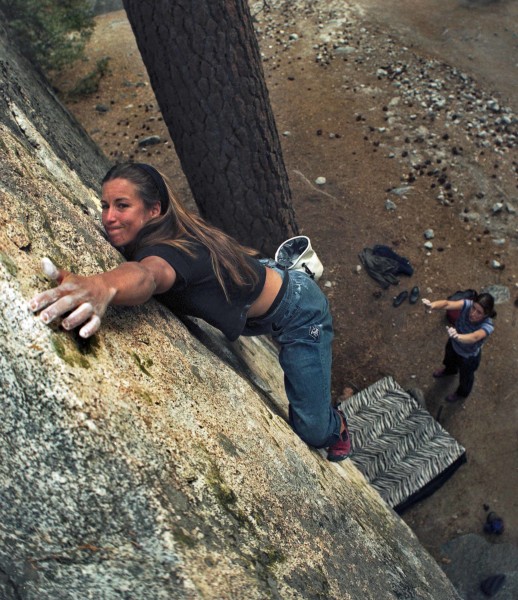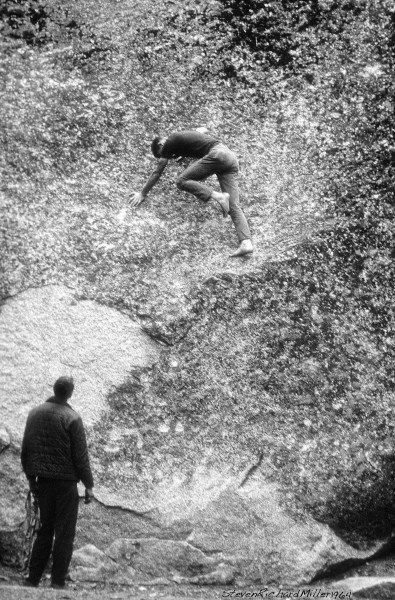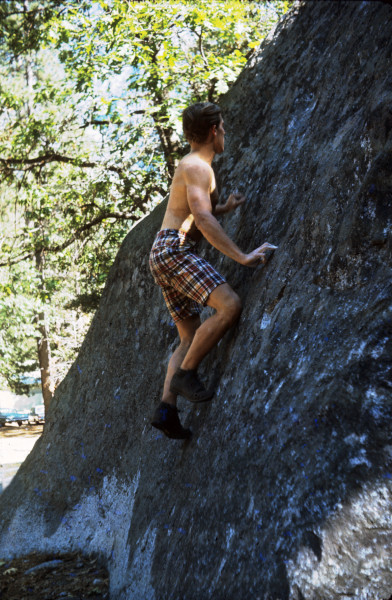In the past few years, Yosemite has become a mecca, not for the enormous walls, but for the immaculate granite boulders. Midnight Lighting, Thriller, and Dominator are names thrown around any crashpad-filled campfire in the world. And while these classics were established in the late seventies to early nineties, the history of Yosemite bouldering extends far earlier.
 For many early Yosemite climbers, the boulders in Camp 4 served as a training ground. They were seen as a way to prepare for longer climbs. As early as the 1940s, Allen Steck, Royal Robbins, Yvon Choinard, Jeff Foote and Chuck Pratt established boulder problems around the campground. They focused primarily on mantels and slabs around Columbia Rock and the Wine boulder. Pratt was well known as the best boulderer in the group. His ability lead to a circuit of hard problems along the trail that runs along the north side of the Wine Boulder. Unlike Robbins, who was often found in the boulders, Pratt was a rarly spotted without a harness.
For many early Yosemite climbers, the boulders in Camp 4 served as a training ground. They were seen as a way to prepare for longer climbs. As early as the 1940s, Allen Steck, Royal Robbins, Yvon Choinard, Jeff Foote and Chuck Pratt established boulder problems around the campground. They focused primarily on mantels and slabs around Columbia Rock and the Wine boulder. Pratt was well known as the best boulderer in the group. His ability lead to a circuit of hard problems along the trail that runs along the north side of the Wine Boulder. Unlike Robbins, who was often found in the boulders, Pratt was a rarly spotted without a harness.
“One night,” wrote Pat Ament in an email correspondence, “drunk and in army boots, Chuck flowed up a route on Columbia Boulder that would test the best, most sober of climbers with their good shoes and chalk, in broad daylight. Mostly out of curiosity, I repeated this route. It starts in about the middle of the west side of Columbia Boulder, just right of the Steck Overhang, and after about three body lengths traverses upward and right, across the big open slab that forms the top half of the rock’s west face. This was scary and with more lichen now probably than when Chuck did it. If I fell I would take a long fall to the ground. It was hard to imagine how Pratt could have done such a route, and in those army boots, at night, drunk.”
Gradually, bouldering became more than just drunken antics. One of the most striking lines in Camp 4 was established by Colorado climber Layton Kor. “Layton did not boulder much,” said Ament. “But one winter day in 1963 or 64, he ambled over to a tall chunk of granite near the east end of Camp 4. With his huge reach and long, spread-out body, Layton on-sighted the rock’s smooth west face, which became known as the Kor Boulder. The route was no walk up! Checking in at V3, the problem remains a classic. Ament continued, “The Kor problem – as much as any other – would serve as a measure of a Yosemite boulderer’s prowess or whether or not a big-wall climber was in shape. It became a ritual for many to work up to the Kor Boulder, as they readied themselves for the walls.”
 The men climbed without crashpads and in old shoes, Spiders and Kronhoeffers, which are far cries from the modern sticky rubber. Still they managed a few difficult face problems. In the late 1960s, Tom Higgins, a Tahquitz Rock and Tuolumne Meadows climber, climbed the Higgins Face, a steep slab on the north side of the trail west and across from the Wine boulder. Currently rated V3, Higgins stood on the balls of his feet to climb the smooth face. The level of difficulty solidified and expanded into harder climbing by a few committed climbers.
The men climbed without crashpads and in old shoes, Spiders and Kronhoeffers, which are far cries from the modern sticky rubber. Still they managed a few difficult face problems. In the late 1960s, Tom Higgins, a Tahquitz Rock and Tuolumne Meadows climber, climbed the Higgins Face, a steep slab on the north side of the trail west and across from the Wine boulder. Currently rated V3, Higgins stood on the balls of his feet to climb the smooth face. The level of difficulty solidified and expanded into harder climbing by a few committed climbers.
Pat Ament had a huge influence on Yosemite bouldering. Considered to be the first climber to focus primarily on bouldering, he made significant advances to the sport. With a history in gymnastics, he brought chalk into the Valley. While the idea of using chalk seems commonplace now, back in the late 60’s it revolutionized the climbing game. Additionally, Ament also repeated many of the testpiece boulder problems and then added his own. “One evening in Camp 4, around 1968, I asked Dick Dorworth if he would spot me on the overhanging arete of a boulder. Dick was not a serious climber but had just set the world speed record at downhill skiing. After having gorged myself on an enormous spaghetti dinner, I made the first ascent of what was later named ‘Ament’s Arete,’ not far from the start of the Falls trail at the northeast corner of Camp 4.” The problem, which Ament stand started, is a difficult V4.
Ament also climbed a difficult slab next to his arete. The technical slab wasn’t repeated for years, despite significant improvement in climbing shoes. A pencil-eraser-sized foothold broke off the slab and the problem became infinitely more difficult. Eventually Ron Kauk repeated the problem and despite a different first ascentionist, the problem became known as ‘The Kauk Slab.’
 The boulders also provided a place for climbers to develop their hardware skills. The Pratt Boulder, the boulders in the talus above the Camp 4 trail, and big Columbia allowed climbers to test hardware and ideas. Early wall climbers nailed the cracks. They established rivet ladders. On big Columbia, they chiseled a path up the slab. In later cases, climbers reinforced holds with glue. These experiments helped greatly in the development of aid climbing techniques. Unfortunately, these practices greatly impacted the rock, and are now considered unacceptable.
The boulders also provided a place for climbers to develop their hardware skills. The Pratt Boulder, the boulders in the talus above the Camp 4 trail, and big Columbia allowed climbers to test hardware and ideas. Early wall climbers nailed the cracks. They established rivet ladders. On big Columbia, they chiseled a path up the slab. In later cases, climbers reinforced holds with glue. These experiments helped greatly in the development of aid climbing techniques. Unfortunately, these practices greatly impacted the rock, and are now considered unacceptable.
The early days of Yosemite bouldering were adventurous to say the least. Slight developments in technique and later advances in climbing shoes rocketed the standards for climbing. These early problems set a base on which the climbers of the seventies and eighties were able to develop the more well known classics.

